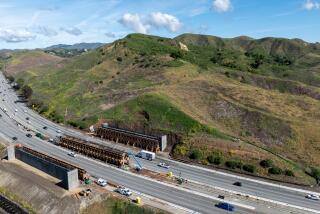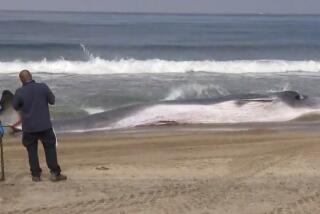Clears Second Major Obstacle : Wayward Whale Stays on River to Freedom
RIO VISTA, Calif. â With a little last-minute help from the U.S. Army, a humpback whale made its way under the Rio Vista drawbridge Saturday and down the Sacramento River but eluded efforts to blockade it in a channel for the night.
A flotilla of 13 small boats, joined by two Army troop transport ships, finally herded the 40-foot whale under the half-mile-long span late in the afternoon after a long day of frustration and miscues.
âItâs south of the bridge!â shouted a rescue coordinator over a two-way radio as the whale emerged from under the drawbridge--the second major obstacle it had crossed in as many days.
The wayward whale, called âE.T.â by some and âHumphreyâ by others, has been in the Sacramento River Delta for more than two weeks, after making a wrong turn from the Pacific into San Francisco Bay Oct. 10.
Reached Dead-End Slough
One of fewer than 10,000 humpbacks in existence, the leviathan ultimately reached dead-end Shag Slough 60 miles from the ocean, where it lived for nearly a week until rescuers drove it out on Friday.
The whaleâs safe passage under the Rio Vista drawbridge Saturday brought relief to the rescue team and hundreds of onlookers who had watched in horror as the whale became stranded in shallow water 90 minutes earlier.
The humpback, with its blowhole and dorsal fin protruding from the water, was stuck for nearly half an hour as it rotated in circles on the muddy river bottom. Finally, it squirmed its way into deeper water and swam free.
The day was also marred when the National Marine Fisheries Service fired explosives into the air to scare the whale without warning volunteers on boats less than 20 yards from the animal.
Two marine biologists who have helped lead the rescue effort for more than two weeks left the fleet in anger and threatened to end their participation.
And the Marine Fisheries Service suffered another setback when it failed to receive a radio signal from a transmitter one of its biologists had attached to the whale with suction cups Saturday morning.
The whale began the day in Shag Slough just downstream from the Liberty Island bridge, which rescuers had herded it past on Friday. Valos Brownell, a farmer who lives nearby, spotted the whale and called in a group of his farmhands to bang on the bridge railing and prevent the whale from swimming back under the bridge.
Heads Downstream
âWe put men on the bridge to beat on the pipes,â Brownell said. âThe whale turned around and headed downstream.â
Later in the morning, Jim Lecky, a wildlife biologist with the Marine Fisheries Service, attached the transmitter on the whale using a 16-foot pole. He was uncertain later whether the device had failed or fallen off. Another attempt will be made today to put a transmitter on the whale, Lecky said.
Small craft operated by volunteers herded the whale about 10 miles downstream from Shag Slough to this little river town and its large drawbridge.
But for more than four hours, the whale swam in circles near the bridge and refused to go under.
Explosive Charges Fired
In an attempt to frighten the whale into swimming under the structure, a Marine Fisheries Service agent fired two loud explosive charges into the air to create a noise the whale would hear.
Fired with no warning, the first shot passed between two boats that were about 50 feet apart and within 20 yards of the whale.
The whale did not react visibly, but the volunteer crews on the boats certainly did. Debbie and Mark Ferrari, two volunteer marine biologists who helped inspire the rescue effort, came ashore and sharply criticized the agencyâs tactic of trying to scare the animal.
âItâs not of any benefit to the whale,â Mark Ferrari said. âPeopleâs health and safety are being jeopardized. If the National Marine Fisheries Service is going to continue handling this the way they are, we are going to quit.â
Gave No Warning
Later, Lecky acknowledged that his agent gave no warning before the shots were fired.
âWe knew there would be adverse public reaction to it so we tried to keep it quiet,â he explained.
About 40 minutes after the explosions, the whale headed north and stranded itself on the mudflat, but Lecky said there was no connection between the two events.
After the animal freed itself, the rescue team called in the Army vessels and used them as a backup to block the whaleâs escape while the smaller craft moved forward more aggressively in a semicircle to drive the whale under the bridge.
Hoped to Trap It
Once on the other side, the fleet herded the whale downriver toward Horseshoe Bend, a small channel where they hoped to trap it for the night.
However, as darkness fell, the animal resisted all efforts to drive it into the channel.
Despite the dayâs various setbacks, rescue leaders were pleased with their success and hoped to prod the whale into the Pacific Ocean within the next several days. Four bridges, all of them high and with plenty of clearance, remain between the whale and the Pacific.
More to Read
Sign up for Essential California
The most important California stories and recommendations in your inbox every morning.
You may occasionally receive promotional content from the Los Angeles Times.










